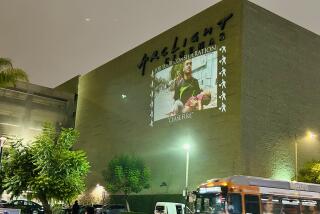Paint the Town and Make It Mad : Can’t Anything Be Done About the Graffiti Grime Wave?
A few people claim graffiti is art. It’s not. Da Vinci is art. Graffiti is garbage.
But graffiti gangsters have been spraying public surfaces with such kaleidoscopic garbage since the days of the Pharaohs. Even the pyramids did not escape this aesthetic plague.
Today there’s hardly a blank wall in central Los Angeles that doesn’t bear stylized lettering left there by some distinctly unfunny non-artist (often, but not always, a member of a gang) who had nothing better to do with his time than deface someone else’s property.
Last year county government spent $9 million trying to clean it up, the city of Los Angeles another $3.7 million, and the Southern California Rapid Transit District $4.3 million. Not to mention the tidy fortune various police agencies have spent chasing graffiti artists.
State Sen. Art Torres (D-Los Angeles) thinks the police have more pressing things to do than round up graffiti gangsters. And he’s right. He thus proposes to deprive the perpetrators of the chief tool of their trade by making it a lot harder to buy spray paint. And that’s right, too.
He’d ban the sale of spray paint cans statewide, except those used by commercial firms, starting in 1992. It’s a tempting idea, but would the bill be effective? (Already one begins to hear counter-arguments from the spray-can and paint industries: “Spray cans don’t deface walls; people deface walls!”)
Probably an outright ban is unfair to the manufacturers--and most likely ineffective.
But there’s something else in the Torres bill we like: He’d require paint retailers to store spray-paint cans in locked display cabinets, starting next year. Many don’t do that now, as they should.
That makes sense. There’s already a state law against selling spray-paint cans to minors, and Torres figures locked cabinets would keep those cans from being shoplifted.
It’s worth a shot.
More to Read
Sign up for Essential California
The most important California stories and recommendations in your inbox every morning.
You may occasionally receive promotional content from the Los Angeles Times.










